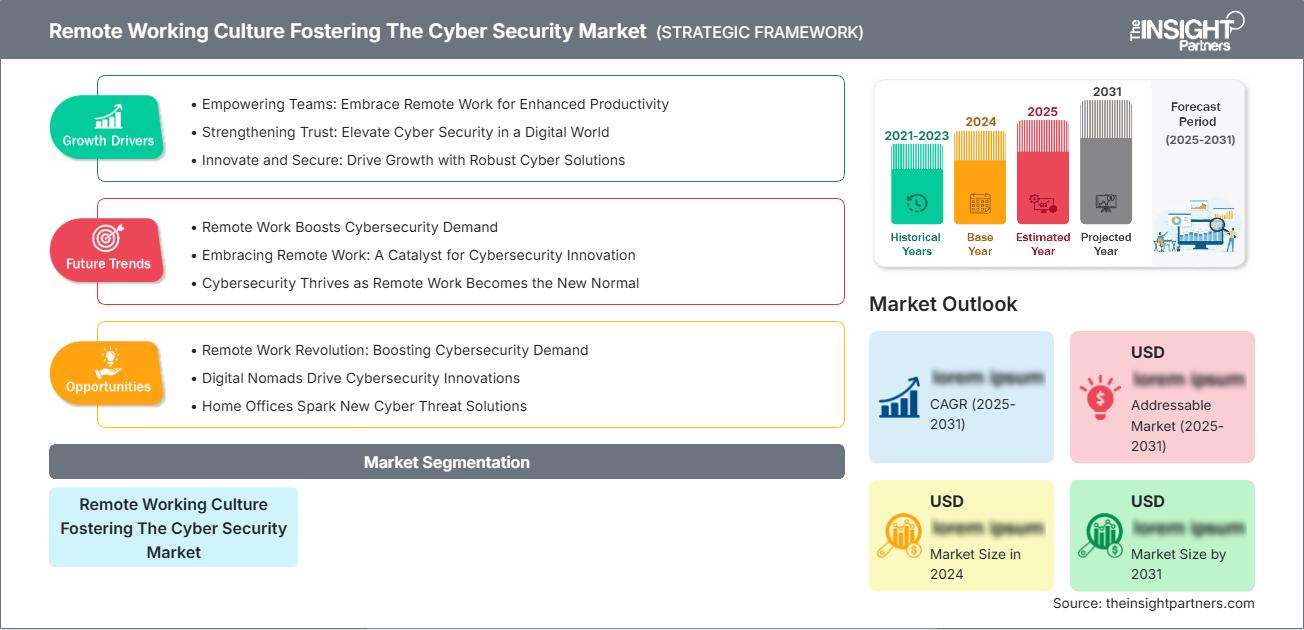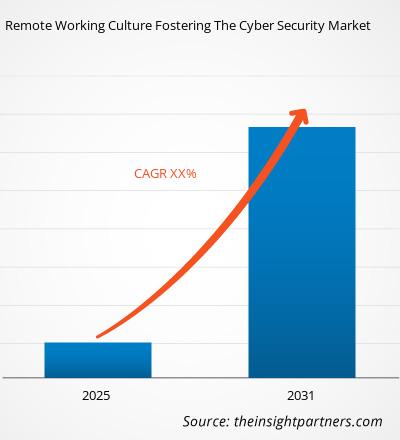Le soluzioni di sicurezza informatica proteggono dall'uso illecito o non autorizzato dei dati elettronici, mentre i servizi di sicurezza informatica rappresentano i processi globali per garantire la sicurezza e la protezione dalle minacce informatiche più comuni. Le soluzioni di sicurezza informatica contrastano malware, ransomware, phishing e attacchi DDoS (Distributed Denial of Service) attraverso un'ampia gamma di misure di sicurezza di rete progettate per proteggere la rete, i dati e il sistema. Molte soluzioni di sicurezza informatica disponibili includono minacce persistenti avanzate, intelligence sulle minacce, gestione degli eventi di sicurezza e informazione, gestione delle vulnerabilità, antivirus, firewall e gateway web sicuro.
Impatto del COVID-19
Durante la pandemia di COVID-19, il governo e le autorità di regolamentazione hanno imposto alle organizzazioni pubbliche e private di adottare nuove pratiche per lavorare da remoto e mantenere il distanziamento sociale. Durante la pandemia di COVID-19, il modo digitale di fare business è diventato un nuovo Piano di Continuità Operativa (BCP) per diverse organizzazioni a livello globale. Con l'adozione di pratiche di lavoro da remoto, dispositivi BYOD, la tendenza al lavoro da casa (WFH) e la diffusione di Internet in tutto il mondo, organizzazioni e individui sono esposti all'utilizzo di tecnologie digitali, il che rende sempre più necessaria l'adozione di soluzioni di sicurezza informatica per ridurre al minimo il rischio di attacchi informatici.
Riceverai la personalizzazione gratuita di qualsiasi report, incluse parti di questo report, analisi a livello nazionale, pacchetto dati Excel e potrai usufruire di fantastiche offerte e sconti per start-up e università.
Cultura del lavoro a distanza che promuove il mercato della sicurezza informatica e la sua geografia (Nord America, Europa, Asia Pacifico e America meridionale e centrale)Mercato: approfondimenti strategici

-
Scopri le principali tendenze di mercato di questo rapporto.Questo campione GRATUITO includerà analisi dei dati, che spaziano dalle tendenze di mercato alle stime e alle previsioni.
Regolamenti chiave
I vari standard sono progettati per migliorare la sicurezza informatica e contribuire alla gestione del rischio. Ad esempio, i Federal Information Processing Standards (FIPS) 140-2 e i Security Requirements for Cryptographic Modules stabiliscono requisiti standard per tutti i sistemi di sicurezza basati sulla crittografia utilizzati dalle organizzazioni federali per proteggere dati sensibili o di valore. Gruppi internazionali, regionali, nazionali, industriali e governativi sviluppano standard di sicurezza informatica. La missione principale di un'organizzazione per lo sviluppo di standard (SDO) è lo sviluppo di standard di consenso volontario su base internazionale, regionale o nazionale. Alcuni degli standard di conformità alla sicurezza informatica che costituiscono una solida base per qualsiasi strategia di sicurezza informatica sono il Federal Information Security Management Act (FISMA), il DFARS (Defense Federal Acquisition Regulation Supplement), l'Health Insurance Portability and Accountability Act (HIPAA), ISO 22301, ISO/IEC 27001 e il NIST Cybersecurity Framework (CSF).
Tendenze regionali
In termini di area geografica, il Nord America detiene una quota significativa, seguito da Europa e Asia-Pacifico (APAC) nel mercato globale delle soluzioni di sicurezza informatica. La presenza di diversi importanti fornitori di soluzioni di sicurezza informatica nella regione contribuisce alla crescita del mercato. Attori chiave come IBM, Microsoft Corporation, Oracle Corporation e Fortinet offrono soluzioni e servizi di sicurezza informatica avanzati per soddisfare le esigenze dei clienti. Inoltre, il governo sta adottando diverse iniziative in paesi come Stati Uniti, Canada e Messico per rafforzare la propria infrastruttura di rete e ridurre al minimo il rischio di attacchi informatici. Ad esempio, il governo del Canada (GC), nel Piano Strategico per le Operazioni Digitali (DOSP) del paese per il 2021-2024, approva un piano triennale lungimirante a livello aziendale per stabilire la direzione strategica per la gestione integrata di servizi, informazioni, dati, tecnologie dell'informazione (IT) e sicurezza informatica. Tali iniziative governative contribuiscono alla crescita del mercato delle soluzioni di sicurezza informatica in Nord America.
Si prevede che il mercato delle soluzioni di sicurezza informatica nella regione APAC crescerà al CAGR più elevato durante il periodo di previsione. L'aumento del numero di attacchi informatici contro il governo e le infrastrutture critiche nella regione APAC si traduce in maggiori investimenti in tecnologie di sicurezza informatica per rafforzare le capacità di rilevamento e risposta alle minacce. Secondo l'IBM X-Force Threat Intelligence Index, l'India ha registrato il secondo numero più alto di attacchi informatici dopo il Giappone nella regione APAC nel 2021. Inoltre, secondo il rapporto, il settore finanziario e assicurativo è stato il principale settore attaccato in India (60%), seguito dal settore manifatturiero e dai servizi professionali.
Cultura del lavoro a distanza che promuove la sicurezza informatica
Cultura del lavoro a distanza che promuove il mercato della sicurezza informatica e la sua geografia (Nord America, Europa, Asia Pacifico e America meridionale e centrale) Approfondimenti regionali di mercato
Le tendenze e i fattori regionali che influenzano il mercato e la geografia (Nord America, Europa, Asia Pacifico e America Meridionale e Centrale) del mercato della sicurezza informatica durante il periodo di previsione sono stati ampiamente spiegati dagli analisti di The Insight Partners. Questa sezione analizza anche i segmenti di mercato e la geografia (Nord America, Europa, Asia Pacifico e America Meridionale e Centrale) del mercato della sicurezza informatica in Nord America, Europa, Asia Pacifico, Medio Oriente e Africa e America Meridionale e Centrale.
Cultura del lavoro a distanza che promuove il mercato della sicurezza informatica e la sua geografia (Nord America, Europa, Asia Pacifico e America meridionale e centrale) Ambito del rapporto di mercato
| Attributo del report | Dettagli |
|---|---|
| Dimensioni del mercato nel 2024 | XX milioni di dollari USA |
| Dimensioni del mercato entro il 2031 | XX milioni di dollari USA |
| CAGR globale (2025 - 2031) | XX% |
| Dati storici | 2021-2023 |
| Periodo di previsione | 2025-2031 |
| Segmenti coperti | Cultura del lavoro a distanza che promuove il mercato della sicurezza informatica |
| Regioni e paesi coperti |
America del Nord
|
| Leader di mercato e profili aziendali chiave |
|
Cultura del lavoro a distanza che promuove il mercato della sicurezza informatica e la sua geografia (Nord America, Europa, Asia Pacifico e America meridionale e centrale). Densità degli attori del mercato: comprendere il suo impatto sulle dinamiche aziendali.
La cultura del lavoro da remoto promuove il mercato della sicurezza informatica e la sua geografia (Nord America, Europa, Asia-Pacifico e America Centrale e Meridionale). Il mercato è in rapida crescita, trainato dalla crescente domanda degli utenti finali dovuta a fattori quali l'evoluzione delle preferenze dei consumatori, i progressi tecnologici e una maggiore consapevolezza dei vantaggi del prodotto. Con l'aumento della domanda, le aziende stanno ampliando la propria offerta, innovando per soddisfare le esigenze dei consumatori e capitalizzando sulle tendenze emergenti, alimentando ulteriormente la crescita del mercato.

- Ottieni la cultura del lavoro a distanza che promuove il mercato della sicurezza informatica e la sua geografia (Nord America, Europa, Asia Pacifico e Sud e Centro America). Panoramica dei principali attori del mercato.
Analisi della concorrenza e sviluppi recenti
Tra i principali attori del mercato figurano Fortinet, Oracle Corporation, Microsoft Corporation, Micro Focus International plc, Rapid7, NortonLifeLock Inc. (Symantec Corporation), Trend Micro Inc., FireEye, Check Point Software Technologies, Cisco Systems, Inc. e International Business Machines Corporation. Le aziende si concentrano su strategie di lancio di prodotti per rimanere competitive e acquisire una base clienti più ampia. Di seguito sono riportati alcuni dei recenti sviluppi:
Nell'ottobre 2021, Comtech Telecommunications ha lanciato una nuova gamma di prodotti e servizi di sicurezza informatica per supportare le attività di monitoraggio e valutazione delle minacce, formazione e sviluppo della forza lavoro dei clienti.
A novembre 2021, Check Point Software Technologies Ltd. ha lanciato la sua piattaforma di sicurezza informatica unificata di nuova generazione, Check Point R81. La nuova piattaforma offrirà una prevenzione autonoma delle minacce progettata per l'intera azienda distribuita, consentendo al personale IT di gestire gli ambienti di rete più complessi e dinamici in modo rapido ed efficiente.
Nel settembre 2021, Bharti Airtel Ltd. ha lanciato una suite di soluzioni di sicurezza informatica per grandi, medie e piccole imprese che stanno passando a piattaforme digitali e cloud, aumentando la necessità di proteggere dati e informazioni dagli attacchi online.
A luglio 2021, Google Cloud ha annunciato due nuove offerte di sicurezza, Confidential VMs e Assured Workloads, per consentire alle amministrazioni pubbliche di fornire ai clienti strumenti di sicurezza avanzati a supporto della conformità e della riservatezza dei dati.
- Analisi storica (2 anni), anno base, previsione (7 anni) con CAGR
- Analisi PEST e SWOT
- Valore/volume delle dimensioni del mercato - Globale, Regionale, Nazionale
- Industria e panorama competitivo
- Set di dati Excel
Report recenti
Testimonianze
Motivo dell'acquisto
- Processo decisionale informato
- Comprensione delle dinamiche di mercato
- Analisi competitiva
- Analisi dei clienti
- Previsioni di mercato
- Mitigazione del rischio
- Pianificazione strategica
- Giustificazione degli investimenti
- Identificazione dei mercati emergenti
- Miglioramento delle strategie di marketing
- Aumento dell'efficienza operativa
- Allineamento alle tendenze normative






















 Ottieni un campione gratuito per - Cultura del lavoro a distanza che promuove il mercato della sicurezza informatica e la sua geografia (Nord America, Europa, Asia Pacifico e Sud e Centro America)
Ottieni un campione gratuito per - Cultura del lavoro a distanza che promuove il mercato della sicurezza informatica e la sua geografia (Nord America, Europa, Asia Pacifico e Sud e Centro America)